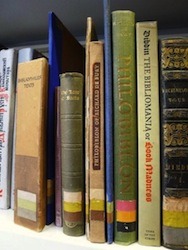Q&A with Resident Mara Goldwyn
1/ Why are you in London?
As Slavs and Tatars put it in the presentation of our recent book Friendship of Nations: Polish Shi’ite Showbiz, here at the Mosaic Rooms last week, everything the collective does begins and ends with books—except, of course, that a book is never an end, it is always another beginning.
As I am the group’s designated “idea detective” or perhaps “research directrice”—two terms I imagine to be polite euphemisms for a hopeless bibliomaniac like myself—I came to London to hunt for books. The Warburg library was one of my main destinations; the unpretentious and intuitive style of browsing there suits well our “lateral” thinking and research strategies. I was not disappointed: I seemed to have tracked down unlikely ancient links between Turkic-Oghuz tamgas and Polish noble Sarmatian crests, the “psychogenetic” sources of letters, and some interesting theories by a mysterious turn-of-last-century gentleman named Sheikh Habeeb Ahmed about the numerological value of particular phonemes over several alphabets.
2/ What are your impressions of the city?

3/ Where have you come from and what is happening there right now?
I’ve come from my home in Berlin, Kreuzberg, where I’ve lived for many years now. Or as is the word du jour among the arterati, I’m based there.
The phrase based in Berlin pretty much sums up what’s happening in the city—people are rolling through like snails and not gathering much moss, but leaving behind a trail of creative slime, so to speak.
There’s a cultural-capital bubble in Berlin that’s absolutely bulging at the moment, which, in my opinion, the city engages by producing ever more tragicomic imitations of itself. That is not to say that there aren’t still interesting things happening there; maybe I’m just falling out of love… I just want my baby back the way she used to be.
4/ What was the last exhibition you saw and what did you think?
I had the chance to see the exhibition of Karl Bloßfeldt— breathtaking photographs and meticulous iconographic cataloguing of the “artforms” in plantlife—at the Whitechapel here in London. He was known for his 1929 book of photographs, Urformen der Kunst.
Moments of overlap between science and its mystical forbears tend to excite me, especially those from the nethertime at the beginning of the 20th century, when the modern world was still working out the kinks. It’s always nice to have a reminder that those kinks are still pretty kinky. That is, no matter how far our telescopes can see, how many particles we collide or genes we splice, there is still a yawn of uncertainty as to what energy or force compelled all this beauty to be. It’s exhilarating.
5/ Who practising at the moment inspires you?
That’s a tough one. To be safe, I’ll just say the whole independent publishing industry, exemplified by our latest publisher, Book Works. The lack of distance—and hierarchy—between execution and distribution of ideas is very refreshing to me.
6/ Where are you travelling to next and what are you most looking forward to when you get there?
My next scheduled trip is to Istanbul to do research related to Slavs and Tatars’ current project, Long Legged Linguistics. I’ve spent much of the last several months researching alphabet politics in the former Soviet sphere, chasing down “extra” Cyrillic letters that were generated to represent sounds in Turkic, Finno-Ugric, Altaic and other types of languages, and now the focus is on a particular Turkic phoneme, ng, and its corresponding “extra” Arabic grapheme in contemporary Uighur and Ottoman Turkish, ? . This is a letter that does not exist in the Arabic language but was rather made up to approximate a Turkic sound. While the sound and the letter are still hanging around Uighuristan in Western China, with the dramatic Romanization (“modernization”) of Turkish in Turkey in the late 20s, ng was dropped from the Turkish alphabet and, it seems, downplayed in the spoken language, now still traveling only very subtly through noses… nnnggg.
As I am writing this there have been further eruptions in Taksim and Gezi squares, it seems a particularly apt moment to be investigating the complexities of Turkish/Turkic national identities and the stakes of language politics…
7/ Where do you hope to be in five years?
I’ll quote Slavs and Tatars quoting an old Soviet maxim, “The future is certain. It is only the past that is unpredictable.”
Thank you Mara!
Mara was resident whilst undertaking research in London for the upcoming Slavs & Tartars solo engagements at the Dallas Museum of Art and GfZK Leipzig in 2014. Visit their website.